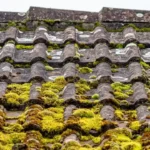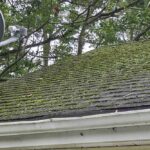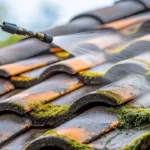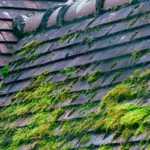Moss on your roof might seem harmless, but it can lead to significant issues when it begins spreading to your yard. This phenomenon not only affects the aesthetic appeal of your property but can also lead to structural and environmental challenges. Understanding why roof moss spreads to your yard is crucial for effective prevention and management.

Understanding Roof Moss
Moss is a simple plant that thrives in damp, shaded environments. While it often starts growing on roofs due to moisture and shade, it can quickly spread to yards, especially if the conditions are conducive. The spores from the moss can travel through the air, landing on various surfaces in your yard.
How Does Roof Moss Spread to Yards?
The spread of moss from the roof to the yard is primarily due to wind and rain. When the wind blows, it can carry the tiny spores from the moss on your roof to your yard. Additionally, rain can wash these spores off the roof, allowing them to settle and grow in your yard.
The Impact of Moss on Your Yard
Once moss finds its way into your yard, it can create a dense carpet that competes with grass and other plants for nutrients. This can lead to unhealthy plants and a less vibrant lawn. Moreover, moss can make the ground slippery, posing a safety hazard.
Preventing Roof Moss Spread
To prevent roof moss from spreading to your yard, it’s essential to maintain a clean and dry roof. Regular cleaning and maintenance can help reduce moss growth. You can learn more about effective cleaning techniques by visiting Moss Removal Dos and Don’ts.
Regular Roof Inspections
Conducting regular inspections can help identify the early signs of moss growth. Early detection allows for timely intervention before the moss has a chance to spread to your yard.
Proper Yard Maintenance
Maintaining your yard by trimming overhanging branches and ensuring proper drainage can minimize the chances of moss thriving. A well-maintained yard is less likely to provide the damp, shaded conditions moss requires.
Effective Moss Removal Techniques
There are several methods to remove moss from roofs and prevent its spread. For DIY enthusiasts, there are budget-friendly tips available at DIY Budget Tips. However, for more persistent cases, professional cleaning might be necessary as outlined in DIY vs. Professional Cleaning.
Chemical Treatments
Chemical treatments can effectively remove moss, but they must be used carefully to avoid damaging the surrounding plants in your yard. Always follow the manufacturer’s instructions and consider consulting a professional.
Natural Remedies
Natural remedies, such as using a mixture of water and vinegar, can also help in managing moss. These methods are environmentally friendly and safe for your yard.
Understanding Moss Regrowth
Moss can regrow if not completely removed. Understanding the speed of regrowth can help in planning maintenance schedules. More insights can be found at Regrowth Speed.
Environmental Factors
Factors such as climate and shading play a significant role in moss regrowth. By altering these factors, you can reduce the likelihood of moss returning.
Continuous Monitoring
Regular monitoring of both your roof and yard is essential. This helps in spotting early signs of regrowth and taking prompt action.
Additional Resources
For more information on dealing with roof moss, you can explore this external resource on Moss on Roof.
Conclusion
Dealing with roof moss spreading to your yard requires a proactive approach. By understanding the causes and implementing preventive measures, you can maintain the aesthetic and structural integrity of your property. Regular maintenance and monitoring are key to keeping both your roof and yard moss-free.

FAQ
How often should I inspect my roof for moss?
It’s recommended to inspect your roof at least twice a year, in spring and fall, to catch any early signs of moss growth.
Can moss damage my roof?
Yes, moss can hold moisture against the roof surface, leading to potential damage over time.
Are chemical treatments safe for my yard?
When used according to the manufacturer’s instructions, chemical treatments can be safe. However, it’s important to protect surrounding plants from exposure.
This article contains affiliate links. We may earn a commission at no extra cost to you.








